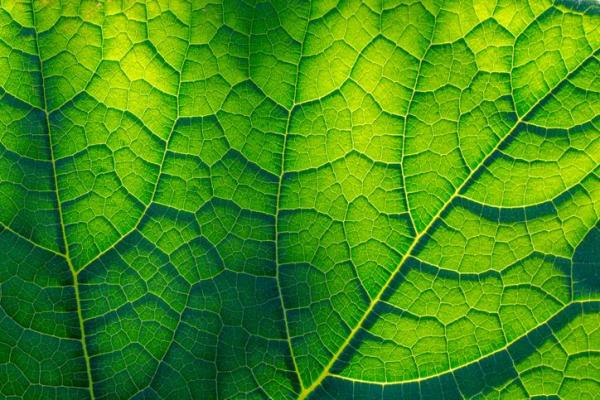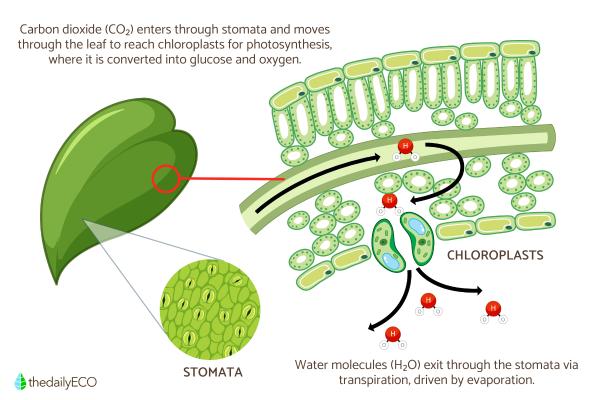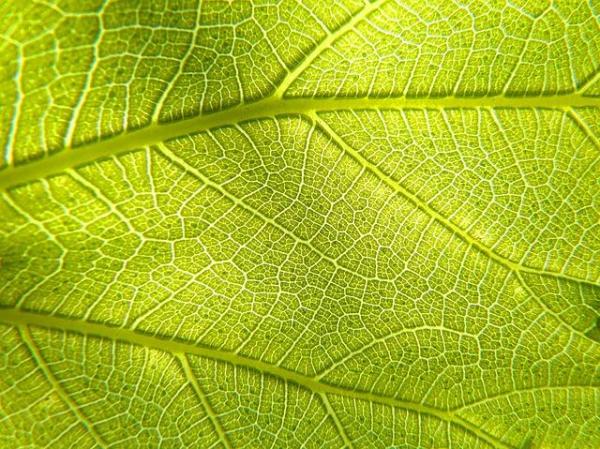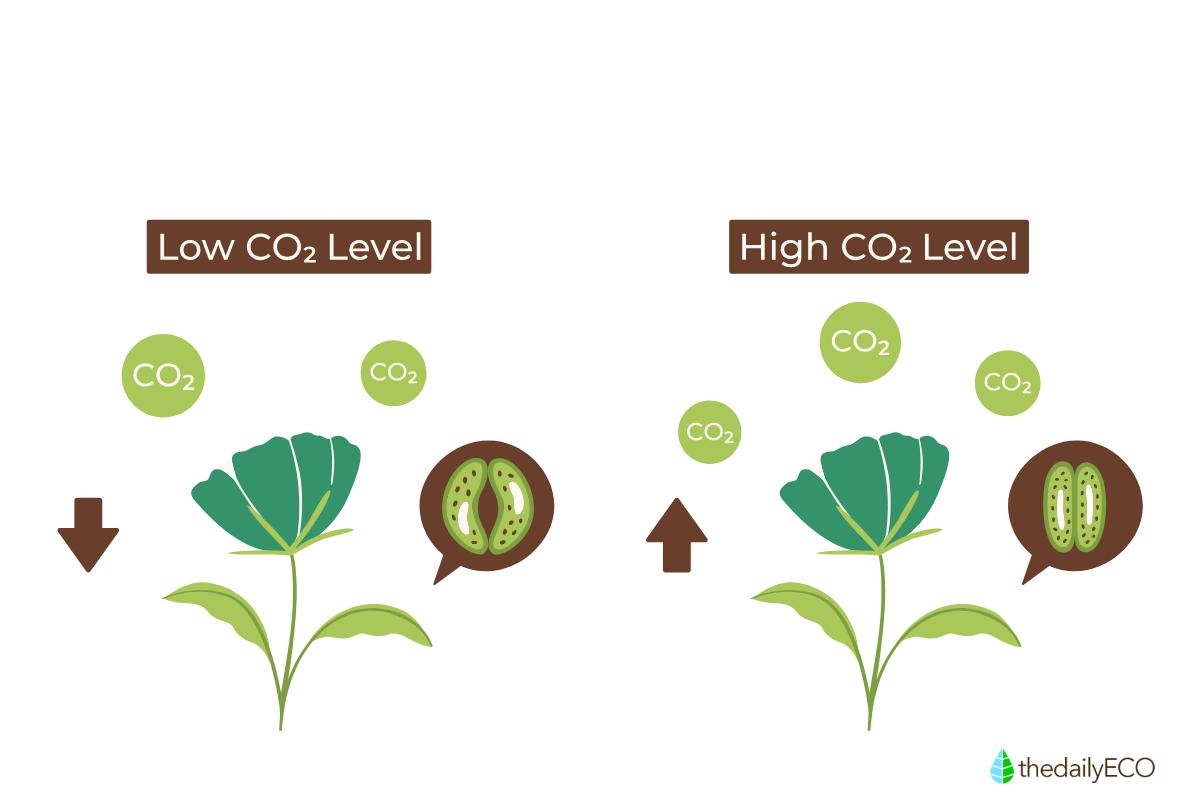Where and How Plants Breathe


It's easy to forget that plants are constantly exchanging gases with the air, a process far more complex than our own breathing. From the tiny pores on a leaf to the massive gas exchange of ocean algae, plant respiration is vital for all life on Earth. Plants don't have lungs like us. Instead, they've developed a clever system that lets them breathe and make their own food while cleaning the air we breathe. Through tiny leaf openings called stomata, they engage in a daily cycle of gas exchange that's essential for their survival and ours.
An article in thedailyECO explores how plants breathe, covering the process of plant respiration from the cellular level to its global impact on Earth's atmosphere. It explains how plants breathe, where this respiration occurs within the plant, and the overall significance of this vital function.
Do plants really breathe?
Plants do engage in a form of breathing, though it is different from how animals breathe. While animals use specialized organs like lungs, plants exchange gases through tiny pores across their surfaces, primarily through small openings called stomata found mostly on their leaves.
Breathing and respiration, though often used interchangeably, are distinct processes. Breathing refers to the physical exchange of gases between an organism and its environment. Respiration, on the other hand, is the cellular process where glucose is broken down to produce energy, requiring oxygen and releasing carbon dioxide as a byproduct. Plants perform both these processes, but their mechanism differs from animals.
Gas exchange in plants occurs through diffusion. During the day, plants take in carbon dioxide through their stomata for photosynthesis, while releasing oxygen as a byproduct. At night, this process partially reverses, and plants take in oxygen for cellular respiration and release carbon dioxide. This dual nature of gas exchange sets plants apart from animals, which consistently inhale oxygen and exhale carbon dioxide.
Stomata are crucial in this process. These microscopic pores, flanked by guard cells, can open and close in response to environmental conditions. When open, they allow carbon dioxide to enter for photosynthesis and permit water vapor and oxygen to exit. When closed, they help prevent water loss during drought conditions, though this also limits gas exchange.

Where do plants breathe?
Plants use tiny openings called stomata to breathe. These are microscopic pores found mostly on leaf surfaces. Each of these pores has two guard cells on either side, which work like automatic doors that can open and close. When these guard cells fill with water, they curve outward like a pair of bananas, creating an opening. When they lose water, they collapse inward, sealing the pore shut.
These pores do two vital jobs:
- First, they let carbon dioxide in during the day for photosynthesis.
- Second, they allow oxygen to enter, which plants need for cellular respiration (breaking down food for energy), just like we do.
The opening and closing of stomata isn't random. Plants sense their environment and respond accordingly. During a drought, for example, a plant hormone called ABA (abscisic acid) signals the guard cells to close, preventing water loss. On a sunny day with plenty of water, the stomata open wide to maximize photosynthesis.
In other words, stomata is essentially the plant's way of balancing two crucial needs: getting enough carbon dioxide for food production while preventing excessive water loss. Ever wonder what's really in every breath you take? Explore the invisible mixture that both plants and humans depend on in our fascinating breakdown of Earth's atmosphere.

The process of gas exchange in plants
The movement of gases in plants relies on diffusion, which is the natural movement of molecules from areas of high concentration to low concentration. This process doesn't require energy, which makes it highly efficient.
Inside leaves, carbon dioxide concentrations are typically lower than outside because plants constantly use CO₂ for photosynthesis, creating a natural flow inward.
Here's how the gas exchange process works:
- Carbon dioxide from the air enters through open stomata, where its concentration is higher outside than inside the leaf.
- This CO₂ moves through intercellular spaces (air pockets between cells) until it reaches cells that perform photosynthesis.
- As photosynthesis occurs, oxygen is produced as a byproduct and moves in the opposite direction, from inside the leaf (where concentration is higher) to the outside air through the same stomatal openings.
Several environmental factors influence this exchange. Temperature plays a crucial role by affecting the rate of photosynthesis, which in turn influences gas exchange needs. Humidity also has a significant impact, as it determines how readily stomata open. Additionally, light availability drives the rate of photosynthesis and influences the stomatal opening response.
Plants have evolved different strategies for gas exchange based on their environments:
- C3 plants (like wheat and rice): perform traditional photosynthesis, opening stomata during the day.
- C4 plants (such as corn and sugarcane): have a more efficient carbon-fixing process that helps them thrive in warmer climates.
- CAM plants (including cacti and pineapples): open their stomata at night to minimize water loss, storing CO₂ for use during daylight hours.
This variety in gas exchange strategies shows how plants have adapted to different environmental challenges while maintaining essential breathing processes.

How photosynthesis and respiration work together
Plants use two key processes to maintain life: photosynthesis and respiration.
During photosynthesis, chloroplasts (specialized cell structures containing chlorophyll) capture sunlight energy. This energy powers the conversion of carbon dioxide and water into glucose and oxygen. The carbon dioxide enters through stomata while water comes up from the roots.
During daylight hours, plants produce more oxygen through photosynthesis than they need, releasing the excess into the air. At night, without sunlight, photosynthesis stops, but plants continue to perform cellular respiration in their mitochondria. This process breaks down glucose (either directly from photosynthesis or from stored starch) to produce energy for growth and maintenance, using oxygen and releasing carbon dioxide, similar to how animals breathe.
Plants have evolved two types of respiration to meet different needs:
- Mitochondrial respiration runs continuously, breaking down stored carbohydrates for energy regardless of light conditions.
- Photorespiration occurs only in daylight and acts as a protective mechanism, preventing leaf damage by dissipating excess light energy - like a built-in surge protector.
Despite using oxygen at night through respiration, plants produce far more oxygen during daytime photosynthesis, making them net oxygen producers, crucial for life on Earth. The rhythm of plant breathing is just as fascinating as how they breathe. Dive deeper into plant circadian rhythms in our related article.

The importance of plant breathing for the ecosystem
Plant respiration, particularly through photosynthesis, plays a vital role in maintaining Earth's breathable atmosphere. While all plants both consume and produce oxygen, their net effect is positive oxygen production, making them essential for life on Earth. A single mature tree can produce enough oxygen to support two humans' breathing needs.
The concept of Earth's lungs refers to our planet's major oxygen-producing regions. Forests, particularly tropical rainforests, are significant oxygen generators, but contrary to popular belief, marine plants and algae in our oceans actually produce about 50-80% of Earth's oxygen. These aquatic organisms, though microscopic, collectively have an enormous impact on global oxygen levels due to their vast numbers and distribution.
Carbon sequestration through plant breathing helps fight climate change. As plants take in carbon dioxide for photosynthesis, they convert it into biomass (leaves, stems, roots) and release oxygen as a byproduct. Some of this carbon gets stored long-term in woody tissues or soil, effectively removing it from the atmosphere. This process is especially effective in old-growth forests and established grasslands, where complex root systems can lock away carbon for centuries.
This delicate balance underscores why protecting and restoring plant ecosystems isn't just about preserving biodiversity, it's crucial for maintaining the very air we breathe and regulating our planet's carbon cycle.

If you want to read similar articles to Where and How Plants Breathe, we recommend you visit our Facts about nature category.
- Calixto, R. (2004) Ways of explaining the process of plant respiration. Perfiles Educativos Magazine (Mexico ), Volume 26, pp: 105-106.
- González, C., Martínez, C. & García, S. (2014) The plant nutrition model throughout history and its importance for teaching. EUREKA Journal on Teaching and Dissemination of Science, Volume 11 (1), pp: 2-12.
- Mosquera-Sánchez, LP, Riaño-Herrera, NM, Arcila-Pulgarín, J. & Ponce-Dávila, CA (1999) Photosynthesis, Respiration and Photorespiration in coffee leaves Coffea spp . Cenicafé Magazine, Volume 50 (3), pp: 215-221.
- Gil-Pelegrín, E., Aranda, I., Peguero-Pina, J.J. & Vilagrosa, A. (2005) The soil-plant-atmosphere continuum as an integrative model of forest ecophysiology. Journal of Agricultural Research: Forest Resources , Volume 14 (3), pp: 358-370.










